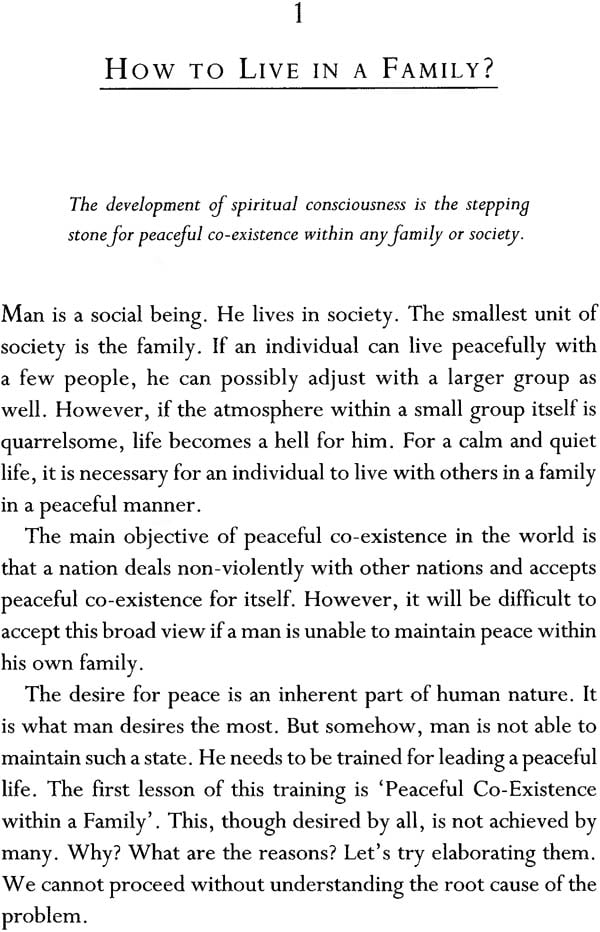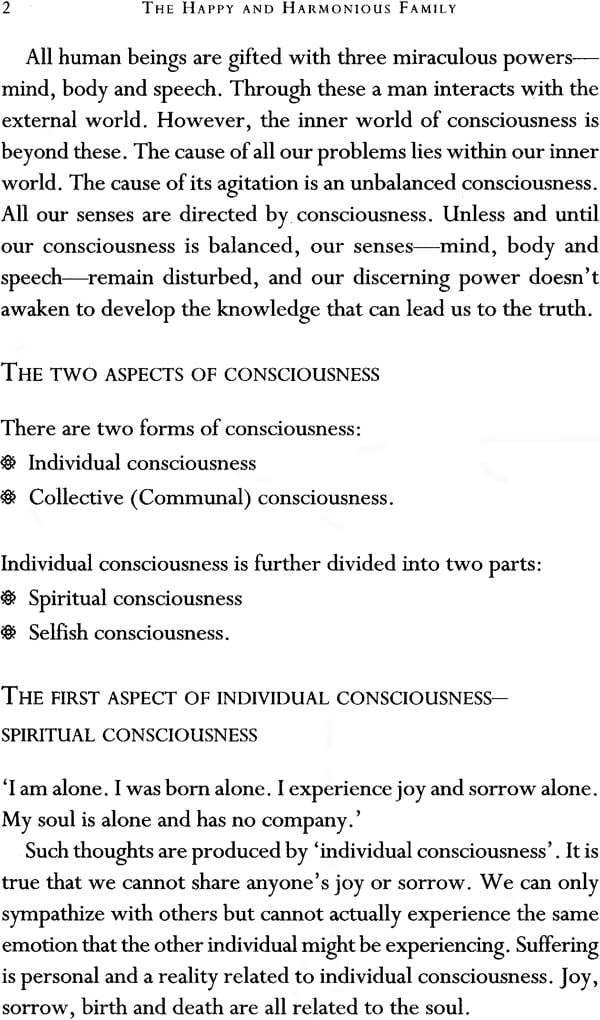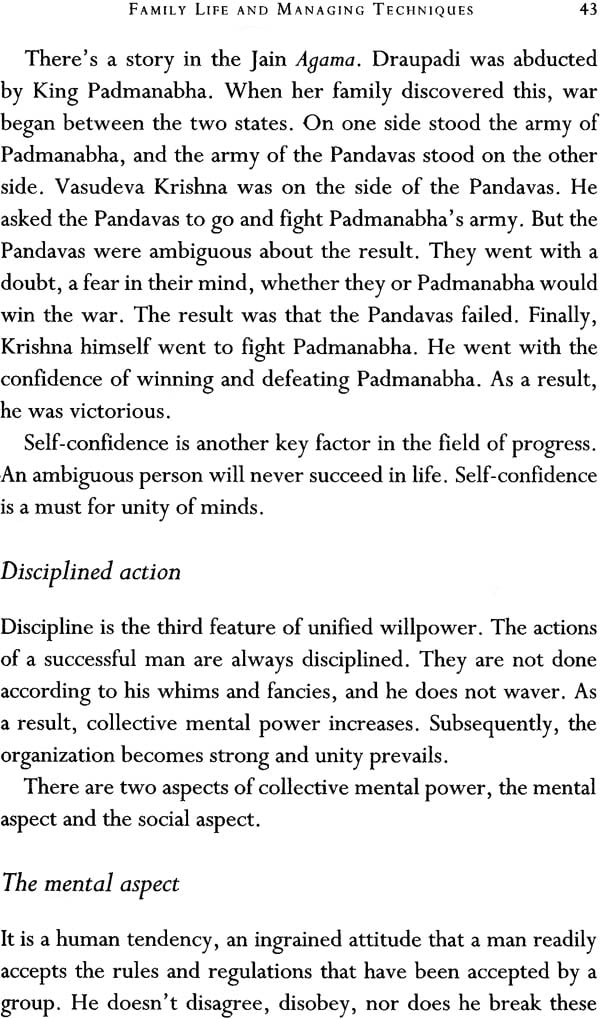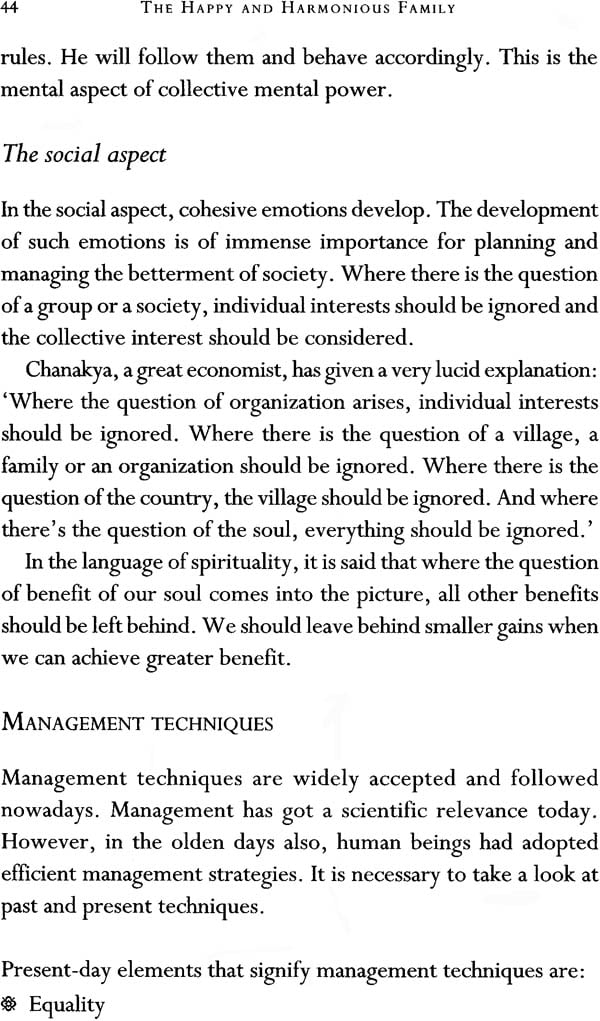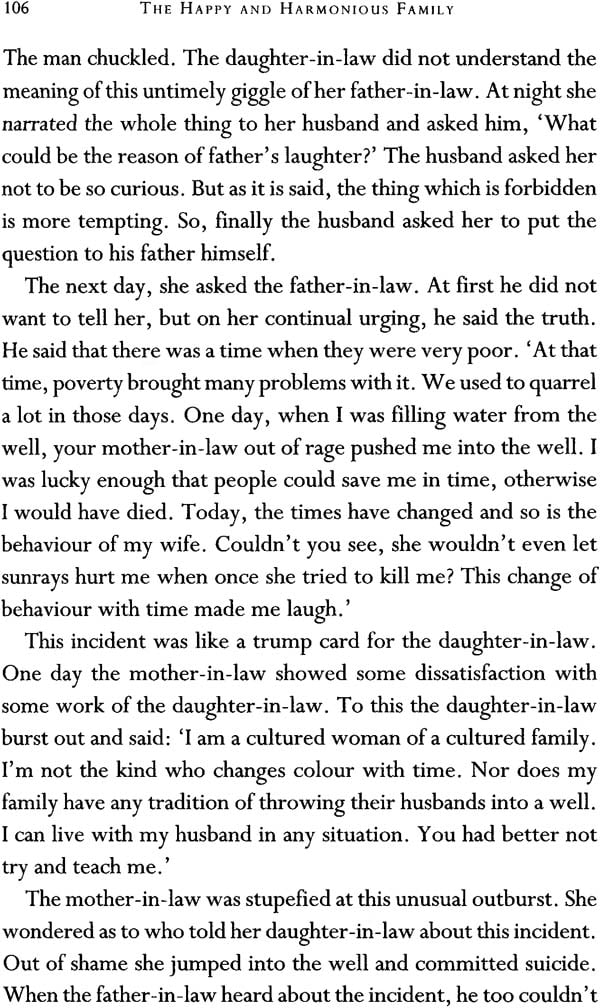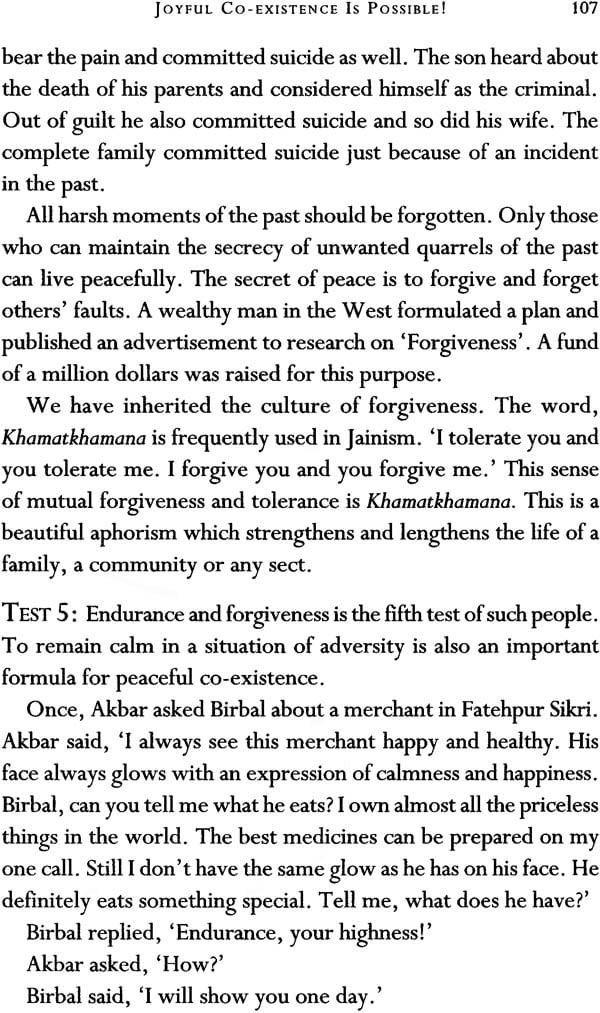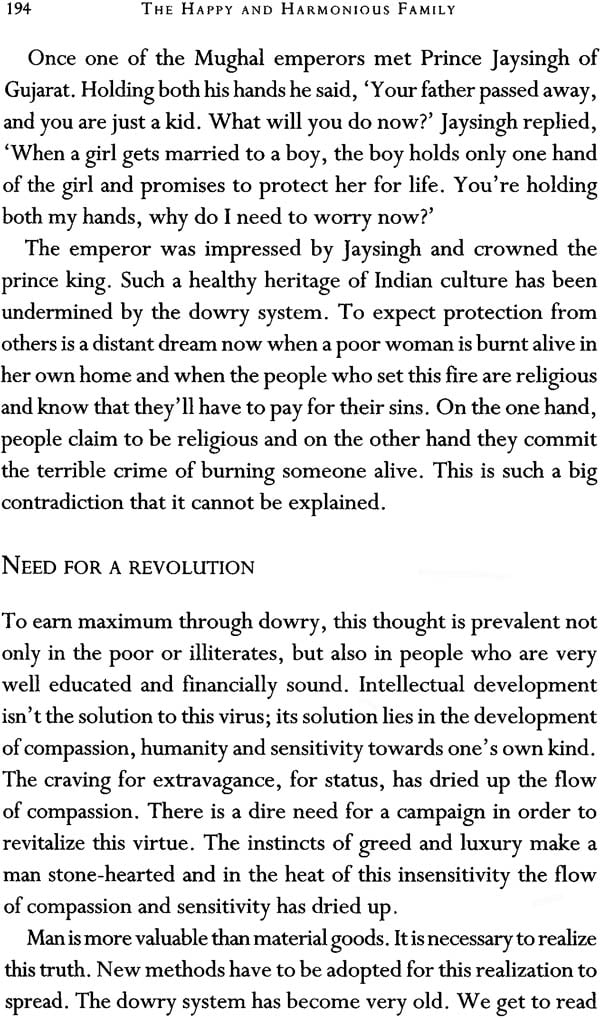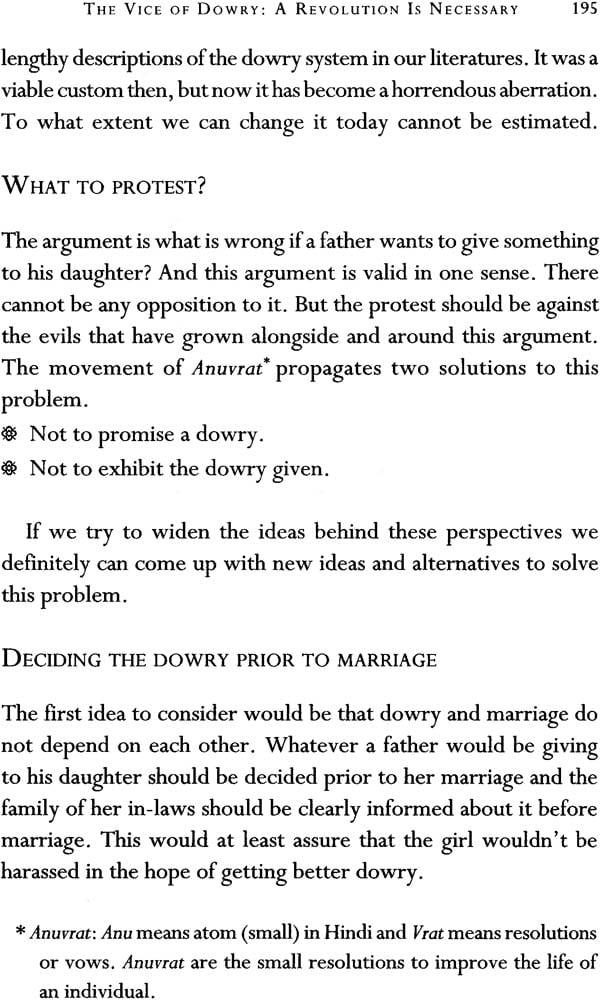
The Happy and Harmonious Family
Book Specification
| Item Code: | NAF594 |
| Author: | Acharya Mahapragya |
| Publisher: | Harper Collins Publishers |
| Language: | English |
| Edition: | 2009 |
| ISBN: | 9788172239442 |
| Pages: | 212 |
| Cover: | Paperback |
| Other Details | 8.5 Inch X 5.5 Inch |
| Weight | 250 gm |
Book Description
About the Book
At the heart of peaceful co-existence in today's fissured world lies the family. It is here that the individual picks up his most fundamental beliefs about himself, and the traits and values that will determine the kind of person he will become. It is here too that he learns to interact with others. In the process he learns that as in the family, so too in the world outside, on two people are the same. Differences are inevitable, and to surmount them tolerance is a must. Not only does this attribute help maintain balance and peace within the family, it makes for a healthier society as will. In the Happy and Harmonious Family, Acharya Mahapragya, the tenth Acharya of the Jain Shwetambra Terapanth sect, discusses these and other aspects of living happily and harmoniously in a family and how these attitudes can be replicated in society.
The subject is all the more importance as the family is itself facing a crisis as it struggles to survive against rising tide of individuality and self- centeredness, so that although living together, family members tend at times to lead separate and isolated lives as they copes with the onslaught of outside pressures.
The Happy and Harmonious Family provides a number of solutions to everyday familial problems, and various practices of contemplative meditation which will enable a reader to overcome negativity within the family. With its emphasis on time-tested valuable and practical solutions, this book is a valuable guide to helping shape a better life.
About the author
Acharya Mahapragya is one of the most celebrated Jain thinkers of the world and is the tenth Acharya of the Jain Shwetambar Terapanth sect. Born in 1920 in a village in Rajasthan, he became a monk at the age of ten. He got his education under the guidance of Acharya Shree Tulsi, who launched the Anuvrat movement in 1949 to rid world of violence and hatred and free religion from sectarianism.
A multidimensional personality and a renowned scholar of Indian and Western philosophy and religion, Acharya Mahapragya is a prolific writer and has been called a ‘modern Vivekananda'. He has traversed more than 100,000 km on foot and visited 10,000 villages to spread the message of non-violence. To this purpose he embarked on an Ahimsa Yatra in 2001. He was honoured with the Communal harmony Award in 2004 for his contribution in this field.
Foreword
There are two importance values for leading a successful and satisfying family life. These are assurance and trust. Relationships cannot be sustained without these. In order to lead a blissful and peaceful life, we must nurture the seeds of trust within our families. The system of joint family has always been based on these values. Family life should be organized in such a manner that no member feels left out or isolated.
Tolerance is the protective armour for any joint family. Mutual understanding is the vital force behind it. Unfortunately, the power of tolerance and the feeling of mutual dependence are reducing day by day.
With development of the virtues of tolerance and peaceful co-existence, one can individually and collectively bloom in a joint family. We can imbibe these values by learning, practicing and sharing them with our family and friends. That is why ‘contemplation' has been incorporated to develop the values of amity, compassion, tolerance, co-existence and reconciliation in this book.
This book is a humble effort at moving one's thoughts towards and strengthening one's conviction regarding the many benefits of a joint family.
Mukhya Niyojika Sadhvi Vishrut Vibha has translated the text into English. I hope that book will encourage people to understand the true meaning of a happy family.
I am happy that HarperCollins has taken up this book for publication. I hope this will help the book reach out to a wider audience.
Contents
| Foreword | ix |
| Translator's ?note | xi |
| Chapter 1: How to live in a family | 1 |
| Chapter 2: How to maintain peaceful co-existence | 9 |
| Chapter 3: How to maintain harmony | 18 |
| Contemplative meditation for the virtue of amity | 28 |
| Chapter 4: Learn to rectify: don't fight | 30 |
| Chapter 5: Family life and managing techniques | 40 |
| Chapter 6: Nine factors for peaceful co-existence | 64 |
| Contemplative meditation for the virtue of co-existence | 80 |
| Chapter 7: Peaceful co-existence and courtesy of Discourse | 82 |
| Chapter 8: Sweeten your relationships | 89 |
| Chapter 9: Joyful co-existence is possible! | 96 |
| Contemplative Meditation for the virtue of tolerance | 112 |
| Chapter 10: Peaceful life and the vision of harmony | 114 |
| Chapter 11: The effective Mantra of Peace in the Family | 123 |
| Chapter 12: Build a spiritual family | 133 |
| Contemplative meditation for the virtue of compassion | 142 |
| Chapter 13: Developing a spiritual home | 144 |
| Chapter 14: How to instil good values | 157 |
| Chapter 15: Family life: problems and solutions | 177 |
| Chapter 16: The vice of dowry: a revolution is necessary | 192 |
| Contemplative meditation for the virtue of reconciliation | 198 |
